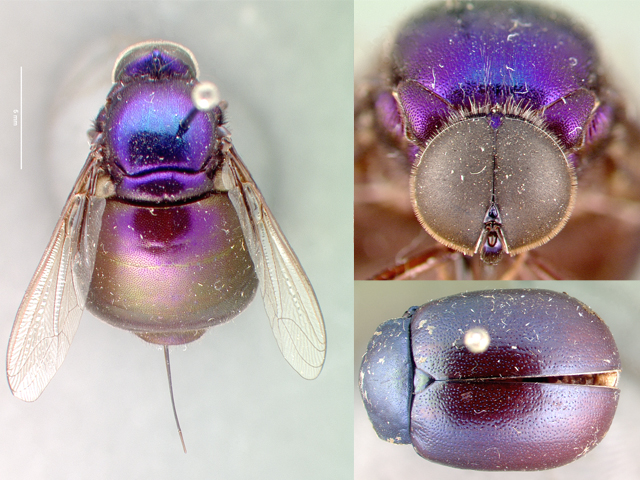 Lasia klettii: Фотографії Ейпріл Нобіле, КЕЙС
Lasia klettii: Фотографії Ейпріл Нобіле, КЕЙС
Здебільшого мухи не є комахами, якими я надто захоплююся. Однак, винятком є загадкова родина Acroceridae. Час від часу почну ділитися деякими цікавими родами – морфологія сімейства дивовижно різноманітна. Більшість своїх днів я проводжу в музеї, інвентаризуючи нашу величезну колекцію 16,000 Акорцериди (також дрібноголові мухи). Це може здатися не дуже вражаючим, якщо порівняти його з іншими більш багатими сім’ями (і він блідне в порівнянні з більш 17,500,000 інший екземпляри, які ми маємо в музеї); але виявляється, що він представляє багатьох, якщо не більшість, з всі відомі екземпляри для всієї родини. Хоча в інших установах, ймовірно, є великі скупчення цих мух, Каліфорнійська академія наук може легко претендувати на рекорд з моменту отримання колекції Dr. Еверт І. рулон (який час від часу заходить на роботу з музею).
Акроцериди виявляються досить складною для вивчення групою, оскільки вони рідкісні в природі, їх паразитоїдна біологія, і як важко їх зловити на крило. Їхня велика грудна клітка наповнена м’язами, які запускають муху в повітрі – тож якщо ви не зловите їх біля квітки, ви залишитеся тужити за пасткою для недуги. Єв розповіла мені одну історію, як навчилася ловити їх на крило в Коста-Ріці. Ви стоїте за вітром від колеги з поля – як тільки хтось почує, що щось пролітає, ти шалено розгойдуєшся, сподіваючись випадково схопити муху… це працює час від часу. Ці мухи також є єдиними відомими ендопаразитами дорослих павуків (може бути запис тахінід…). Вищевказаний рід, НеоЛася, є паразитом Theraphosid тарантулів (щось на зразок Афонопельма). Як личинка, муха піднімається по ногах павука і заривається в черевце, де потім оселяється поруч із книжковим легенем і пробиває невеликий дихальний отвір.. Потім він терпляче чекає, поки павук наблизиться до зрілості. З самками тарантулів, муха може перебувати в бездіяльності десятиліттями. Згодом відбувається щось подібне до фільму Інопланетяни, і личинки харчуються внутрішніми органами павука, а потім з’являються, щоб окуклитися.. Але з’ясувати, чи є у павука паразит, неможливо без розтину – тому великі колекції живих павуків повинні підтримуватися для отримання записів про господарів. Паразитоїдна біологія - це так круто.
Наведений вище зразок (Lasia klettii новий, безіменний, види) був зібраний в 1977 Шлінгером поблизу міста Аламос, Мексика – на квіти з імовірною моделлю імітації, жук Chrysomelidae (жуки люди, будь-які ідеї за межами родини?).

Very interesting! Out of curiosity, because you mention large collections of live spiders, has any researcher reached out to the hobby tarantula keepers in a quest for specimens? While I have never seen something as spectacular as the above emerge from a wild caught tarantula, I have heard from a few people who ended up with “strange” flies in the past…
Reaching out to them for actual tarantulas has lead to quite a few specimens for Brent Hendrixson on his revision of the genus Aphonopelma, at least for the USA native species. There also are frequently imports of various species brought in from Central and South America, which is not a practice I like or am comfortable with…but it might lead to at least a few specimens given the numbers involved. Just a thought.
I think the answer is somewhat. I’ve reached out on message boards and even recently gave a short talk to the SF Bay Area Tarantula Society. The problem comes down to peoples immediate response when they see a giant grub crawling out of their spider – they reach in and grab their prize specimen and in the process damage the larvae or pupae of the emerging fly. As it turns out these flies are pretty sensitive before pupating and while I’ve seen lots of maggot images, never seen a fly reared by a hobbyist. I think the biggest hurdle is that people only discover what they are after they have had a spider die – and chances are it’ll be years before another one of their wild caught immature spiders are parasitized!
That makes a lot of sense, I guess it didnt really occur to me that for most people having a parasite emerge from one of their captives is a bad thing…that sort of thing would make my day. 🙂
Especially if that spider cost you a few hundred dollars!!
I wonder if that fly sees very well. 🙂
First impression of the beetle is a species of Chrysolina (subfamily Chrysomelinae), but my knowledge of Neotropical chrysos is limited.
Thanks for the genus ballpark – I’ll have to dig through our collections here to see if I can’t narrow it down more.
Did you mean that these acrocerid flies are the only known dipteran endoparasites of adult spiders? There are certainly spider-parasitic nematodes, and mantidfly larvae can crawl into the book lungs of their spider hosts and feed on hemolymph while hitching a ride to the egg deposition site.
http://en.wikipedia.org/wiki/Mantispidae
And here’s a cool post about a mantidfly larva on a spider, preserved in amber!
http://blogs.discovermagazine.com/notrocketscience/2011/03/28/spider-boarding-insect-preserved-in-amber/
(Звичайно, that one’s on the outside of the spider, but the post also has more info on other tactics.)
Thank you for pointing that out! You’re correct of course, when I was thinking “no other endoparasitoids” I totally neglected non-insects such as nematodes. I should have recalled how tricky it can be to control nematode infestations in captive bread spiders!
I also did not know that about mantidflies. Actually I should catch up on the literature, there may be other diptera or hymenoptera parasitoids more recently known. Very cool, thanks for the link.
Augh augh augh and here’s a picture of a huuuuuge nematode coming out of a spider! It’s even one of the behavior-modifying parasites — it induces its host to seek out water before dying, so the nematode can complete its life cycle. (Like the horsehair worm in crickets!)
http://www.abc.net.au/science/k2/stn/spider.htm